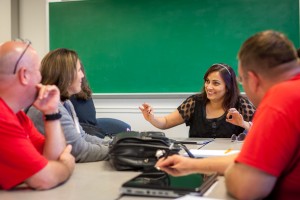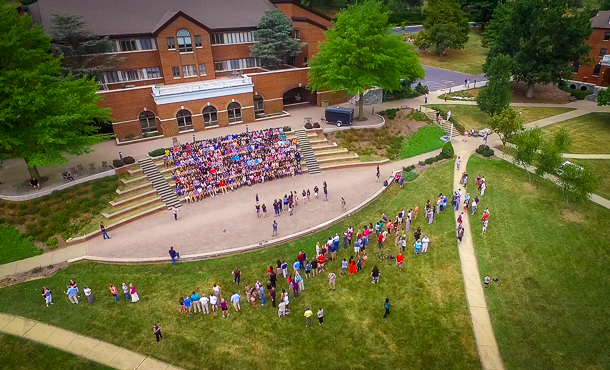Eastern Mennonite University’s traditional undergraduate first-year enrollment for the 2015-16 academic year was its highest in several decades, while graduate programs recorded a 26.4 percent increase in enrollment. The data represents enrollment figures from fall 2014 to fall 2015.
The 2015-16 figures were released by the registrar’s office following the university’s official census date of Sept. 14. The data is collected as a traditional “snapshot” of enrollment trends, according to university registrar David Detrow.
EMU’s incoming traditional undergraduate first-year class, numbering 257 students, is the largest in several decades. From 2001 to 2010, EMU averaged 205 first-year students, according to past records.

As for diversity, a record-high number of students who are ethnic minorities or come from other countries is reflected in 37 percent of this fall’s undergraduate students. That number is up from 36 percent a year ago and 29 percent the year before.
Graduate programs, excluding the seminary but including students from the Lancaster site, enrolled 450 students in comparison to last year’s 356. Seminary enrollment was steady at 133 students.
“The continual increase in enrollment numbers at EMU creates a genuine university feel on campus,” said Luke Hartman, vice president of enrollment. “I am excited that students are discovering that we are a world leader in areas such as sustainability, medical school preparation, faith development and social justice. We are so diverse that everyone can find another who shares a commonality.”
First-year class grows in diversity
Diversity data and other statistics related to the composition and demographics of the first-year class is compiled by the admissions department, under Director of Admissions Jason Good.
“This year’s class has brought a contagious and positive energy to campus,” said Good. “They have impressed me with their academic abilities and their ambitions to be catalysts for positive change in their communities. With overall enrollment growth, new facilities and new academic programs including a new engineering major anticipated to begin in 2016, it is an exciting time to be at EMU.”
In-state students continue to increase, with 61 percent compared to 57 percent last year.
The university continues to be an attractive draw to local residents. This first-year class saw a doubling of enrollment from Harrisonburg High School, increasing from 13 students in fall 2014 to 25 in fall 2015. Graduates of Eastern Mennonite School attending EMU numbered 13 out of a graduating class of 53.
Good noted this first-year class added more students admitted to the Honors Program, and came in with higher SAT scores and grade-point averages than the previous class.
Nearly a third of those new students plan to study biology or nursing – a reflection of EMU’s highly respected and sought-after graduates of both programs. EMU’s STEM programs are housed in the newly renovated Suter Science Center with renovated classrooms and state-of-the-art laboratories.
Restorative justice program highlights overall growth
Much of EMU’s enrollment growth in the last 20 years – since it took the “university” name – is due to the establishment of graduate programs and the Adult Degree Completion Program.
The growth rate across all nine graduate programs was 26.4 percent this fall. The total number of students is 450, compared to last year’s 356.

“Much of the growth in our graduate programs have been fueled by a very entrepreneurial-minded culture among program directors, faculty, and staff,” said Jim Smucker, vice president and dean of the EMU’s School of Graduate and Professional Studies. “In my two years here at EMU, I have experienced a very innovative group of people with a ‘can-do’ spirit who are working in mission-driven ways to expand our educational distinctives to a growing audience.”
Seven of the nine programs gained students, with the master’s in education program, offered at EMU and at the Lancaster site, showing the most growth – a rebound from last year’s decreasing numbers. The program for working teachers has the largest number of part-time students (197 at both Harrisonburg and Lancaster campuses).
After a significant broadening of program offerings in 2014 – three graduate programs debuted in organizational leadership, interdisciplinary studies and a collaborative Master of Business Administration (MBA) – EMU began offering just one new concentration, restorative justice in education.
That program, the first of its kind in the United States, has been a significant draw, says Sara Reed, associate director of marketing and recruitment. Restorative justice in the school community, which has been endorsed by the U.S. Department of Education, can potentially improve student behavior, improve school and classroom communities, and lower suspension and expulsion rates.
EMU’s development of the program is an outgrowth of its pioneering role in teaching restorative justice practitioners through the Center for Justice and Peacebuilding and the Zehr Institute for Restorative Justice, co-directed by professors Howard Zehr and Carl Stauffer.
The master’s programs in counseling, EMU’s oldest graduate program, has been operating at full capacity, with a wait-list for admission, for several years. It was the only program that enrolled the same number of students as in fall 2014.
Seminary numbers steady
Eastern Mennonite Seminary’s enrollment held steady this fall, with the total number of students at 133; however there was a decrease in the full-time-equivalent number due to fewer full-time students.
“Since graduating a near-record 2015 class, we’ve recognized that we would face several challenging years in rebuilding our full-time student numbers,” said Michael A. King, vice president and dean of the seminary. “We’re pleased that a strong recruitment season allowed us to maintain the same headcount across autumn 2014 and 2015. And fewer students departing in 2016 gives us a promising foundation for future enrollment increases.”
One source of rising enrollment are three innovative dual degree programs offered in conjunction with the seminary, said Laura Amstutz, director of admissions. “These programs offer an attractive prospect to many who see professional benefit from inter-disciplinary connections.”
The master’s of divinity can be paired with graduate programs leading to a master’s degree in counseling, conflict transformation, or business administration.
The increase in part-time students can also be traced to the successful inaugural offering of a hybrid program, which combines distance learning with one-week residential sessions. “This program has opened up the possibility of seminary studies to more students with various life circumstances,” Amstutz said.
Seminary students include 57 Mennonites, but also 25 students from the United Methodist Church. In the summer of 2014, the United Methodist Church re-approved EMS – for another four years − for the training of its pastors.
Other Anabaptist groups represented include Church of the Brethren, Brethren and Brethren in Christ. Students of the Baptist and Southern Baptist, Presbyterian, Roman Catholic, Church of God, Seventh Day Adventist, and Unitarian faith traditions are also represented. Some students claim no particular faith tradition.
University community meets diverse educational needs
A total of 1,908 students registered for class at the beginning of the fall semester.

This number includes statistics from all of EMU’s programs, from traditional undergraduate students to non-traditional students in Adult Degree Completion Programs; part- and full-time students in graduate programs at Eastern Mennonite Seminary and in EMU’s School of Graduate and Professional Studies; and students in the Intensive English Program, as well as those taking non-credit courses in conflict transformation.
Among the total enrollment figures are students at EMU’s site in Lancaster, Pennsylvania, and those who study online.
The overall number of students enrolled through EMU’s Lancaster campus in Pennsylvania increased slightly this year. That includes teachers seeking a master’s degree in education, nurses who want to complete their undergraduate degree, and pastors and future pastors who aspire to a seminary degree.
The Intensive English Program at EMU continues to attract strong interest from international students and local immigrants. IEP prepares them for entrance into American colleges and universities. This fall’s student number is slightly lower than last year’s at 75, with the highest number of students coming from Saudi Arabia and China. A total of 15 countries are represented.
While fall semester brings a new burst of energy to campus, the summer included significant activity of its own. Well over 900 persons enrolled for one or more summer courses through EMU. This included approximately 433 for credit in graduate programs, 40 for seminary credit, and 242 for undergraduate credit including 60 Adult Degree Completion students taking general education courses. Also included are 53 students in the Intensive English Program, more than 80 non-credit participants who joined 70 graduate students (included in the total above) for EMU’s Summer Peacebuilding Institute, and many additional participants in non-credit courses offered by the Center for Justice and Peacebuilding.
“This data is indeed a valuable ‘snapshot’ that shows our two campuses are part of a thriving academic community that draws students of all ages from around the world for study and engagement during the year,” said Provost Fred Kniss. “I’m very pleased to see continued growth in the size and quality of our incoming classes in both our undergraduate and graduate programs, and other programs as well. I’m even more pleased to see the increasing diversity in our student body and faculty, which will enhance the educational experience of our entire community of learning.”
